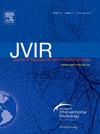结合放射栓塞和免疫检查点抑制剂治疗肝细胞癌:寻求协同作用。
IF 2.6
3区 医学
Q2 PERIPHERAL VASCULAR DISEASE
Journal of Vascular and Interventional Radiology
Pub Date : 2024-11-23
DOI:10.1016/j.jvir.2024.11.012
引用次数: 0
摘要
肝细胞癌(HCC)是导致全球癌症相关死亡的主要原因之一,而且发病率还在不断上升。以 Y-90 放射栓塞(Y-90-RE)为形式的肝脏导向疗法和以免疫检查点抑制剂(ICI)为形式的全身疗法的最新进展为预后不良的患者提供了更多的治疗选择。尽管取得了这些成果,但 ICIs 和 Y-90-RE 都存在一些关键的局限性,分别是客观反应率低和场外复发的持续危险性,而且总生存率仍然很低。然而,每种疗法的长处都能减轻对方的短处,使它们成为联合治疗策略的理想搭档。本综述讨论了将 Y-90-RE 与 ICIs 结合使用的科学和临床依据,重点介绍了有关其安全性和有效性的早期临床试验数据,并提出了这一新兴领域需要解决的关键问题。如果采用最佳策略,联合疗法有可能为晚期患者带来持久的治疗效果,这在十年前是很少见的。本文章由计算机程序翻译,如有差异,请以英文原文为准。
Combining Radioembolization and Immune Checkpoint Inhibitors for the Treatment of Hepatocellular Carcinoma: The Quest for Synergy
Hepatocellular carcinoma is a leading and increasing contributor to cancer-related death worldwide. Recent advancements in both liver-directed therapies in the form of yttrium-90 (90Y) radioembolization (RE) and systemic therapy in the form of immune checkpoint inhibitors (ICI) have expanded treatment options for patients with an otherwise poor prognosis. Despite these gains, ICIs and 90Y-RE each have key limitations with low objective response rates and persistent hazard of out-of-field recurrence, respectively, and overall survival remains low. However, each therapy’s strength may mitigate the other’s weakness, making them potentially ideal partners for combination treatment strategies. This review discusses the scientific and clinical rationale for combining 90Y-RE with ICIs, highlights early clinical trial data on its safety and effectiveness, and proposes key issues to be addressed in this emerging field. With optimal strategies, combination therapies can potentially result in increasing likelihood of durable and curative outcomes in later stage patients.
求助全文
通过发布文献求助,成功后即可免费获取论文全文。
去求助
来源期刊
CiteScore
4.30
自引率
10.30%
发文量
942
审稿时长
90 days
期刊介绍:
JVIR, published continuously since 1990, is an international, monthly peer-reviewed interventional radiology journal. As the official journal of the Society of Interventional Radiology, JVIR is the peer-reviewed journal of choice for interventional radiologists, radiologists, cardiologists, vascular surgeons, neurosurgeons, and other clinicians who seek current and reliable information on every aspect of vascular and interventional radiology. Each issue of JVIR covers critical and cutting-edge medical minimally invasive, clinical, basic research, radiological, pathological, and socioeconomic issues of importance to the field.

 求助内容:
求助内容: 应助结果提醒方式:
应助结果提醒方式:


